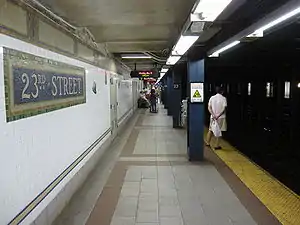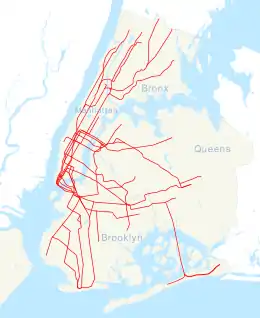23rd Street station (BMT Broadway Line)
23rd Street is a local station on the BMT Broadway Line of the New York City Subway. Located at the intersection of 23rd Street, Broadway, and Fifth Avenue in the Flatiron District of Manhattan, it is served by the R train at all times except late nights, the W train on weekdays, the N train during late nights and weekends, and the Q train during late nights.
23 Street | ||||||||||||||||||||||||||||||||||||||||||||||||||||||||||||||||||||
|---|---|---|---|---|---|---|---|---|---|---|---|---|---|---|---|---|---|---|---|---|---|---|---|---|---|---|---|---|---|---|---|---|---|---|---|---|---|---|---|---|---|---|---|---|---|---|---|---|---|---|---|---|---|---|---|---|---|---|---|---|---|---|---|---|---|---|---|---|
 Northbound platform | ||||||||||||||||||||||||||||||||||||||||||||||||||||||||||||||||||||
| Station statistics | ||||||||||||||||||||||||||||||||||||||||||||||||||||||||||||||||||||
| Address | intersection of 23rd Street, Fifth Avenue & Broadway New York, NY 10010 | |||||||||||||||||||||||||||||||||||||||||||||||||||||||||||||||||||
| Borough | Manhattan | |||||||||||||||||||||||||||||||||||||||||||||||||||||||||||||||||||
| Locale | Flatiron District, Madison Square | |||||||||||||||||||||||||||||||||||||||||||||||||||||||||||||||||||
| Coordinates | 40.741339°N 73.989272°W | |||||||||||||||||||||||||||||||||||||||||||||||||||||||||||||||||||
| Division | B (BMT) | |||||||||||||||||||||||||||||||||||||||||||||||||||||||||||||||||||
| Line | BMT Broadway Line | |||||||||||||||||||||||||||||||||||||||||||||||||||||||||||||||||||
| Services | N Q R W | |||||||||||||||||||||||||||||||||||||||||||||||||||||||||||||||||||
| Transit | ||||||||||||||||||||||||||||||||||||||||||||||||||||||||||||||||||||
| Structure | Underground | |||||||||||||||||||||||||||||||||||||||||||||||||||||||||||||||||||
| Platforms | 2 side platforms | |||||||||||||||||||||||||||||||||||||||||||||||||||||||||||||||||||
| Tracks | 4 | |||||||||||||||||||||||||||||||||||||||||||||||||||||||||||||||||||
| Other information | ||||||||||||||||||||||||||||||||||||||||||||||||||||||||||||||||||||
| Opened | January 5, 1918[1] | |||||||||||||||||||||||||||||||||||||||||||||||||||||||||||||||||||
| Station code | 014[2] | |||||||||||||||||||||||||||||||||||||||||||||||||||||||||||||||||||
| Opposite- direction transfer | No | |||||||||||||||||||||||||||||||||||||||||||||||||||||||||||||||||||
| Traffic | ||||||||||||||||||||||||||||||||||||||||||||||||||||||||||||||||||||
| 2019 | 7,085,694[3] | |||||||||||||||||||||||||||||||||||||||||||||||||||||||||||||||||||
| Rank | 53 out of 424[3] | |||||||||||||||||||||||||||||||||||||||||||||||||||||||||||||||||||
| Station succession | ||||||||||||||||||||||||||||||||||||||||||||||||||||||||||||||||||||
| Next north | 28th Street: N | |||||||||||||||||||||||||||||||||||||||||||||||||||||||||||||||||||
| Next south | 14th Street–Union Square: N | |||||||||||||||||||||||||||||||||||||||||||||||||||||||||||||||||||
| ||||||||||||||||||||||||||||||||||||||||||||||||||||||||||||||||||||
| ||||||||||||||||||||||||||||||||||||||||||||||||||||||||||||||||||||
| ||||||||||||||||||||||||||||||||||||||||||||||||||||||||||||||||||||
| ||||||||||||||||||||||||||||||||||||||||||||||||||||||||||||||||||||
History

This station opened on January 5, 1918, as the BMT Broadway Line was extended north from 14th Street–Union Square to Times Square–42nd Street and south to Rector Street. Service at this station was provided by local services running between Times Square and Rector Street.[1] Service was extended one station to Whitehall Street–South Ferry on September 20, 1918.[4][5] On August 1, 1920, the Montague Street Tunnel opened, extending local service from Lower Manhattan to DeKalb Avenue in Downtown Brooklyn by traveling under the East River.[6][7]
On January 3, 1999, a schizophrenic man, Andrew Goldstein, pushed 32-year-old journalist and photographer Kendra Webdale onto the tracks from the Brooklyn-bound platform of this station. Webdale was then struck and killed by an oncoming N train.[8] After two mistrials due to his mental incapacity, Goldstein pleaded guilty of manslaughter in October 2006 and sentenced to 23 years in prison.[9] The incident led to the passing of Kendra's Law, which allows judges to order people suffering from certain psychological disorders to undergo regular treatment.[10][11]
Station layout
| G | Street level | Exit/entrance |
| P Platform level |
Side platform | |
| Northbound local | ← ← ← ← | |
| Northbound express | ← | |
| Southbound express | | |
| Southbound local | | |
| Side platform | ||
.jpg.webp)
This underground station has four tracks and two side platforms. The two center tracks are used by the N train on weekdays and Q train at all times except late nights. The platforms have their original trim line, which has "23" tablets on it at regular intervals, and name tablets, which read "23RD STREET" in Times New Roman font.
This station's 1970s overhaul included fixing its structure and the overall appearance by replacing the original wall tiles, old signs, and incandescent lighting to the 1970s modern look wall tile band and tablet mosaics, signs and fluorescent lights. It also included fixing staircases and platform edges. In 2001, the station received a major refurbishment, including upgrading the station for ADA compliance, restoring the original late 1910s tiling, repairing the staircases, re-tiling the walls, new tiling on the floors, upgrading the station's lights and the public address system, installing ADA yellow safety threads along the platform edge, new signs, and new trackbeds in both directions.
The 2002 artwork here is called Memories of Twenty-Third Street by Keith Godard. The platform walls feature mosaics depicting hats that famous people of the Flatiron District wore, including Oscar Wilde, Sarah Bernhardt, and W. E. B. Du Bois.[12]
Exits

Each platform has two same-level fare control areas. The primary ones are at the north ends of the platforms. The Queens-bound platform has a bank of regular and high exit-only turnstiles, the station's full-time token booth, and four street stairs. Two go up to the northeastern corner of Broadway and 23rd Street (outside Madison Square Park) and the other two go to the southeast. The Brooklyn-bound platform has a bank of regular and high exit-only turnstiles, a now defunct customer assistance booth, and two street stairs. One is connected to fare control via a passageway and goes up to the southeastern corner of 23rd Street and Fifth Avenue outside the Flatiron Building, while the other goes up to the northeastern corner of Broadway and Fifth Avenue, near a mid-block pedestrian crossing.[13]
The station's other two fare control areas are at the south end of the station. The one on the Manhattan-bound platform is unstaffed, containing High Entry-Exit Turnstiles and one staircase going up to the northeastern corner of 22nd Street and Broadway. The turnstile on the Brooklyn-bound platform is exit-only and has one staircase to the northwest corner of 22nd Street and Broadway.[13] There is a crossunder here that was closed in the 1990s and is now only used for station facilities.
References
- "Open New Subway to Times Square" (PDF). The New York Times. January 6, 1918. p. 3. Retrieved November 5, 2016.
- "Station Developers' Information". Metropolitan Transportation Authority. Retrieved June 13, 2017.
- "Facts and Figures: Annual Subway Ridership 2014–2019". Metropolitan Transportation Authority. 2020. Retrieved May 26, 2020.
- District, New York (State) Public Service Commission First (January 1, 1919). Report of the Public Service Commission for the First District of the State of New York. J.B. Lyon Company.
- Legislative Documents. J.B. Lyon Company. January 1, 1920.
- "New B.R.T. lines open" (PDF). The New York Times. August 2, 1920. p. 17. Retrieved November 5, 2016.
- "Broadway - Fifty-Ninth Street Extension of B.R.T. Subway, Opened to Queensboro Plaza, L.I. City" (PDF). The New York Times. August 1, 1920. p. R-92. Retrieved August 31, 2020.
- Waldman, Amy (January 4, 1999). "Woman Killed in a Subway Station Attack". The New York Times. ISSN 0362-4331. Retrieved August 31, 2020.
- Hartocollis, Anemona (October 11, 2006). "Nearly 8 Years Later, Guilty Plea in Subway Killing". The New York Times. ISSN 0362-4331. Retrieved August 31, 2020.
- Schapiro, Rich (December 5, 2012). "Horrifying subway homicide causes parents to relive daughter's death". NY Daily News. Retrieved October 27, 2015.
- Watkins, Ali (September 11, 2018). "A Horrific Crime on the Subway Led to Kendra's Law. Years Later, Has It Helped?". The New York Times. ISSN 0362-4331. Retrieved August 31, 2020.
- "23rd Street - Keith Godard - Memories of Twenty-Third Street, 2002". web.mta.info. Metropolitan Transportation Authority. Archived from the original on August 31, 2020. Retrieved August 31, 2020.
- "MTA Neighborhood Maps: Union Square / Gramercy" (PDF). Metropolitan Transportation Authority. 2015. Retrieved August 6, 2015.
External links
| Wikimedia Commons has media related to 23rd Street (BMT Broadway Line). |
- nycsubway.org – BMT Broadway Subway: 23rd Street
- Station Reporter — N Train
- Station Reporter — R Train
- MTA's Arts For Transit — 23rd Street (BMT Broadway Line)
- Fifth Avenue and 23rd Street entrance from Google Maps Street View
- Broadway and 23rd Street entrance from Google Maps Street View
- Broadway and 22nd Street entrance from Google Maps Street View
- Platforms from Google Maps Street View



